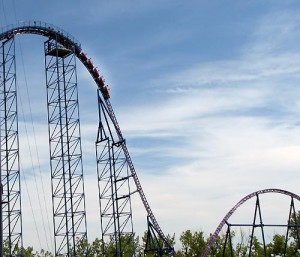 I spent Friday at Six Flags New England amusement park, home to Bizarro, which is the number one steel roller coaster in the country. One ride on Bizarro is worth the trip and the admission price.
I spent Friday at Six Flags New England amusement park, home to Bizarro, which is the number one steel roller coaster in the country. One ride on Bizarro is worth the trip and the admission price.
But I did get to thinking about the admission price, since Six Flags is making some very attractive offers available for repeat admissions to the park. One promotion gives you six visits for $42 and another upgrades your day pass to a season pass for just $40. If amusement parks are so expensive to operate, why make admissions to cheap?
That’s when I began crunching numbers in my head. Here’s what we spent at Six Flags during the day:
Parking: $15
Locker: $14
Drinks: $18
Food: $19
That’s $66 for two people, which is more than the $47 we paid to enter the park. More important is that the margins on that $66 must be north of 90%. Think of it: the parking and locker rental together are $29 and require almost no staff time and very little overhead investment beyond the capital costs. The material cost for the drinks is probably less than 30 cents and labor is zero, since the drinks are self-serve. A couple of sandwiches cost maybe $2 to make and assemble. So Six Flags’ costs for that $66 in revenue is probably less than $3. No wonder the company is so eager to get people to return to the park again and again.
The company is operating its amusement park at break-even or even at a loss and making it up in concessions. In fact, the company probably makes more profit on parking than on the theme park. Interesting economics. How about making those season passes free?

I would love those passes to be free as well, however, theme parks simply can’t afford it.
The money that you spend beyond your ticket price is used to calculate an average value per guest. In theme park lingo, this is called “per cap”. So to Six Flags, you’re worth ticket price + per cap.
What you spent beyond your ticket price was well north of the per cap for most parks. Excluding parking, a large number of people don’t buy anything once they’re in park. No food, drinks, locker rentals, swag, etc. Hard to believe, but true.
Theme parks are hurting right now, in fact, Six Flags filed for chap. 11 bankruptcy in June. Dollars from admissions are integral to the bottom line.
A fascinating use of break even analysis. It really illustrates the different marketing mix that you can profitably create once you really know your cost structure. And a break even analysis goes a long way toward showing your cost structure. Is is helpful in this and many other cases. For more information on how to apply this to your business, regardless of whether you intend to sell or retain it, visit the free info site http://www.selling-a-business-without-stress.com/breakevenanalysis.html,
Six Flags relies on tourist traffic for its profit, and probably much of its revenue. Tourist travel is way down. Local traffic is likely not sufficient to allow it to be profitable.
Tried to sign up for your email list. Got a 404 for your thank you page. Might want to check that.
@Jeremy but (I can’t speak for six flag, but it’s true for most of the parks in the UK) throes food outlets (OK not the locker or the parking) not making money for the park, but for a third party, who in turn is paying the park a hefty chunk of change. It gives the park a fixed income.